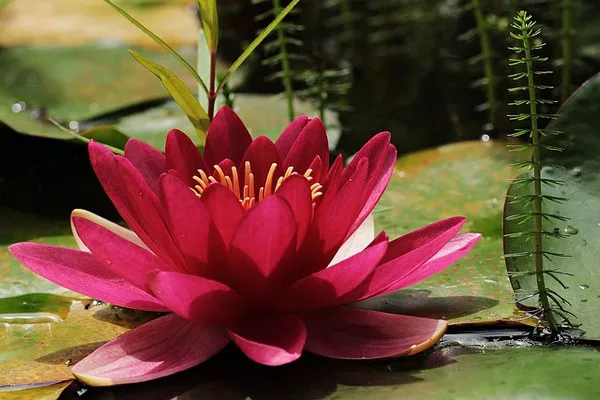Lilies are beloved flowering plants cherished for their elegance, fragrance, and stunning blooms. When grown in pots, lilies add a touch of beauty and sophistication to any indoor or outdoor space. After the delightful display of blossoms fades, proper care becomes essential to ensure the lily’s health and encourage its potential to bloom again. In this article, we will explore the essential steps to take with potted lilies after flowering, enabling these captivating plants to thrive and grace us with their presence year after year.
1. Deadheading Spent Flowers
As the lily blooms begin to fade, it is essential to remove the spent flowers promptly. Deadheading prevents the plant from expending energy on seed production, allowing it to redirect its resources to strengthening its bulb and foliage. Use clean and sharp garden scissors or pruners to snip off the faded flowers just above the nearest healthy leaf or bud. Deadheading will not only enhance the overall appearance of the plant but also encourage the lily to store energy for future growth.
2. Continue Watering and Fertilizing
Even after flowering, potted lilies require consistent watering and proper nutrition to support their post-bloom phase. Keep the soil consistently moist but not waterlogged. Water the lilies thoroughly when the top inch of soil feels dry to the touch. Applying a balanced liquid fertilizer every two weeks will provide the necessary nutrients to sustain the plant and support bulb development.
3. Managing the Foliage
Lilies rely on their leaves to photosynthesize and store energy in their bulbs. It is crucial not to remove the foliage until it starts to yellow and wither naturally. Removing the leaves prematurely can deprive the bulb of vital nutrients, potentially impacting the lily’s ability to rebloom in the following season.
4. Post-Flowering Bulb Care
After the lily has finished flowering and the foliage begins to die back, it is time to consider the bulb’s care. Potted lily bulbs can be left in the same container or transferred to a larger pot to allow for further growth. If you choose to keep the bulb in the same pot, trim the foliage down to soil level once it turns yellow and dries out. Be careful not to damage the bulb during this process.
5. Transplanting and Repotting
Transplanting or repotting the lily bulb is an excellent option for encouraging continued growth and reblooming in subsequent years. Wait until the foliage has completely withered before carefully removing the bulb from the pot. Gently shake off excess soil and inspect the bulb for any signs of damage or disease. If the bulb is healthy, replant it at a depth of around 2 to 3 times its height in a larger container with well-draining potting mix.
6. Bulb Storage in Winter
If you live in a region with harsh winters and the lily is not cold-hardy, it may be necessary to protect the bulb during the colder months. After the foliage has withered, remove the bulb from the pot and place it in a dry, cool location for storage. A mesh bag or a box with peat moss or vermiculite can provide an ideal storage environment. Make sure the bulb remains dry during storage to prevent rot.
7. Dividing Bulbs
Over time, lily bulbs can multiply, leading to overcrowding in the pot. Dividing the bulbs is an effective method to ensure the lilies have ample space to grow and bloom. Dividing should be done during the dormant season, typically in late fall or early spring. Carefully remove the bulbs from the pot and separate the offsets (small bulbs) from the main bulb. Replant the offsets in separate pots or share them with fellow gardening enthusiasts.
8. Pest and Disease Management
Vigilance against pests and diseases is vital for the health of potted lilies. Regularly inspect the plant for any signs of infestation, such as aphids, mealybugs, or lily beetles. Should any pests be detected, take appropriate measures to control them, using natural or chemical methods as necessary. Also, avoid overwatering, as it can lead to root rot and fungal diseases.
9. Reblooming Expectations
While some lily varieties are known for their ability to rebloom annually, others may require more time and care. Reblooming is influenced by factors such as lily variety, growing conditions, and post-flowering care. Patience and consistent care are key to encouraging the lily to rebloom in subsequent years.
10. Selecting Suitable Varieties
When choosing lily varieties for pot cultivation, consider those labeled as suitable for container planting. Dwarf and Asiatic lilies are particularly well-suited for growing in pots, as they have a compact growth habit and offer a wide array of vibrant colors.
Conclusion
Post-flowering care for potted lilies is essential for ensuring the plant’s health, longevity, and potential to rebloom in the future. By deadheading spent flowers, maintaining proper watering and fertilization, managing foliage, and tending to the bulb’s needs, gardeners can help their lilies thrive beyond their stunning display of blooms. With attention to detail, patience, and a touch of green-thumb magic, potted lilies can continue to grace our gardens and living spaces with their elegance and charm for years to come.


